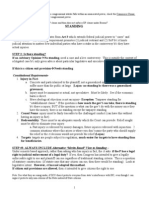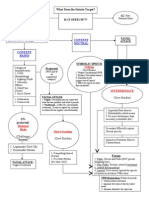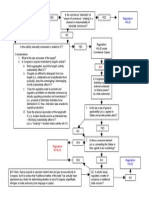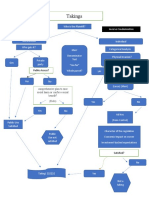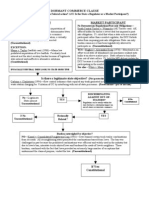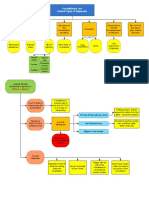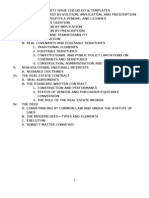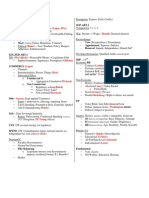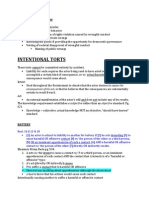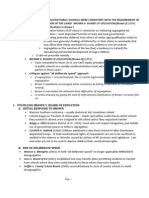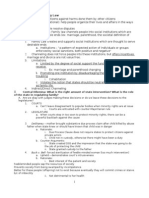ConLaw II Attack Sheet - OD
ConLaw II Attack Sheet - OD
Uploaded by
chetandivyaCopyright:
Available Formats
ConLaw II Attack Sheet - OD
ConLaw II Attack Sheet - OD
Uploaded by
chetandivyaOriginal Description:
Copyright
Available Formats
Share this document
Did you find this document useful?
Is this content inappropriate?
Copyright:
Available Formats
ConLaw II Attack Sheet - OD
ConLaw II Attack Sheet - OD
Uploaded by
chetandivyaCopyright:
Available Formats
Downloaded From OutlineDepot.
com
ConLaw II Attack Sheet
Procedural Due Process:
2 Part Evaluation:
1. Life, liberty, or property being deprived?
2. If yes then what process is due?
Property: defined property NOT based on IMPORTANCE of job to individualbut rather based on the
EXPECTATION of continued employment.
Must be created by an independent source
If people rely on a government benefit in their daily livesthen it should be regarded as a
property interest that must not be arbitrarily undermined.
A property interest only ifthe state law creates a reasonable expectation to receipt of a benefit,
regardless of the importance of the interest.
What process/procedures are due?
Notice: reasonably calculated to apprise the person of what is happening
An opp to heard
o Matthews v. Eldredge (3 Factors to determine process due)
1. Individual interests involved nature of private interests involved
2. Likelihood that procedures challenged will lead to mistake of an erroneous
decision
3. Governments interest in why its using the procedures being challenged.
Benefit
Legally entitled?
Created Expectancy?
Substantive Due Process
Lochner (1905)= creates fundamental right of FREEDOM OF CONTRACT
there must be:
1. adequate health and safety justification
2. actual impact on the safety of the public
Nebbia (1934)= there must be judicial deference to legislative policy making
Change from:
Lochner judicial activism
Nebbia judicial deference
Ct saideconomic regulations should be upheld so long as they are supported by a conceivable
RATIONAL BASIS even if it cannot be proved that that was the legislatures intent.
Griswold (1965)= law violated due process clause because it deprived married persons of the
liberty protected by this fundamental right.
Penumbras and emanations
Downloaded From OutlineDepot.com
Einstadt v. Baird (1972)= struck down statute prohibiting contraceptives to unmarried people;
separate treatment of unmarried persons violated the equal protection clause.
Roe v. Wade (1973)= right of personal privacy includes the abortion decision but that this right is
not unqualified and must be considered against important state interests in regulation
Established trimester approach
Doe v. Bolton (1973)
Invalidated GAs abortion law ct recognized that women have a constitutional
right to abortions prior to viability
Casey (1992) = got rid of trimester requirements and put more weight on states interest in potential
life
Stare decisis= prior ct decisions must be recognized as precedent
one reason why they say they should uphold Roe.
Stenberg (2000) = declared unconstitutional a state law that prohibited partial birth abortion
law = overbroad, vague- no exceptions for mothers health
Undue Burden Test
o If purpose or effect of law is to place a substantial obstacle in the path of a woman
seeking an abortion before the fetus reaches viability
Gonzales (2007) = upheld Partial Birth Abortion Act of 2003: prohibited Partial Birth Abortions,
but anatomical landmarks and mens rea requirements ( filled in what Stenberg left outexcept
for health of mother)
Family Rights:
Moore v. City of East Cleveland (1977) = personal choice in traditional family living arrangements;
Supreme Court recognized fundamental right to keep family together that includes extended family
Village of Belle Terre v. Boraas (1974) = ct upheld an ordinance that zoned for single-family
dwellings with family defined as one or more persons related by blood- thus excluding grps of
unrelated individuals; limited number of unrelated people that could live together in one household.
Did not recognize a fundamental right for NON-family
Troxel v. Granville (2000) : recognizes fundamental rights of parents to make decisions; statute was
overbroad (said any person could have visitation); heightened scrutiny
Loving v. Va : recognized a right to marry as part of due process liberty (also EP)
Homosexual Rights:
Bowers v. Hardwick (1986) = no fundamental rights to sodomy; used rational basis; upheld on basis
of states moral choice
Lawrence v. Texas (2003) = overruled Bowers (struck down a Texas law prohibiting sodomy)
Downloaded From OutlineDepot.com
Kennedy test: the law furthered no legit state interest which could justify its intrusion into
the personal and private life of the individual.
Right to Die:
Washington v. Glucksberg (1997) = upheld law that prohibited assisted suicide, not fundamental
liberty interest that is protected by due process clause
Vacco v. Quill (1997) = NYs prohibition on assisting suicide does NOT violate the Equal Protection
clause
Downloaded From OutlineDepot.com
Equal Protection
Railway Express Agency v. NY (1949): trucks and advertising; statute upheld b/c of ratl basis
review
New Orleans v. Dukes= vendor pushcarts- rationally related to state interest, rational review used,
statute upheld
Suspect Classifications: Race, gender (quasi suspect), alienage, illegitimacy
Loving v. Virginia= statute unconstitutional which prohibited interracial marriages; strict scrutiny;
no compelling governmental justification
Strauder v. West Va= blacks were prohibited from jury service; unconstitutional b/c of stigma
associated with racial discrimination
Palmore v. Sidoti= kid living with mom and black man is NOT illegal; the ct cannot give private
racial biases legal effect
Yick Wo v. Hopkins= Chinese laundry mat applicants denied license; while law was facially neutral,
it purposefully discriminated as applied.
Washington v. Davis= DC police test which 4 times as many blacks failed; test is neutral on its face,
rationally serves govt purpose, applied even
Village of Arlington Heights v. Metropolitan Housing Development Corp = ct found not discrim for
zoning change to include racially integrated housing that was rejected.
Indications of Purposeful discrimination in the case of a Disparate Impact Statute: Background of
law, usual processes, or if the law isnt a typical result in the context
Personnel Administrator v. Feeney= gave male veterans preference in state civil position
Mere awareness of disparate effect is INSUFFICIENT to demonstrate discriminatory intent.
Plessy v. Ferguson= separate but equal
Sweatt v. Painter= separate university for black students; the ct was not only saying that the actual
facilities were not equalbut that it was unequal not to be able tot be part of the educational
interchange in the same way
Downloaded From OutlineDepot.com
Missouri ex rel Gaines v. Canada = Supreme Court held that it was unconstitutional for Missouri to
refuse to admit blacks to its law school, but instead to pay for blacks to attend out-of-state law
schools
McLaurin v. Oklahoma Regents for Higher Education = unconstitutional at graduate school to have
separate seats and spots in library and cafeteria
Brown v. Board= held separate education facilities are inherently unequal under 14th amendment;
racial classifications are outlawed; you are protected against legally enforced segregation
but it is not a continuing obligation on the govt to have integrated schools.
Racial preferences & Affirmative Action:
Regents of the University of CA v. Bakke= minority quota in university; quota system not allowed;
a quota system DOES infringe on equal protection. A quota= way too blunt of an instrument
to achieve a diverse class b/c people must be judged on their individual merits; fulfills
compelling justification (diversity), fails narrowly tailored (quota=bad, other method=?)
Wygant v. Jackson Board of Education (1986)= school districted laid off senior teachers and kept
minority teachers; Ct rejects good effects as a means for justifications of racial classifications;
shot down b/c of no durational limit ( not well-tailored) and there were less intrusive means of
accomplishing similar purposes
City of Richmond v. JA Croson= city sets aside 15% of contracts for minorities struck down; ct
makes firm decision to take strict scrutiny approach to affirmative action cases;
well-tailored
Duration of program
Minimus of harm to neutral whites
Consideration of race-neutral alternatives
How precisely is program tailored to past harm
Metro Broadcasting v. FCC (1990) = ct said it would judge affirmative action case by mid-level
scrutiny; applied mid-level scrutiny to give general deference to Congress; different outcome to case
if strict scrutiny applied
Adarand Constructors, Inc. v Penn (1995) = Court overrules Metro Broadcasting and puts strict
scrutiny of affirmative action back into effectfor federal and state actions
Grutter v. Bollinger (2003)= upheld law school admission policy that used plus factor and was
sufficiently narrowly tailored that each applicant is viewed as an individual NOT QUOTA
(satisfied every aspect of well-tailored looks at people on individualized basis, points NOT
automatic, NO quota, time limit= 25 years). Good effects is ok in higher education context.
Gratz v. Bollinger (2003)= ct says that automatically adding 20 points for minority students =
NOT ok!!! Not sufficiently narrowly tailored- does not look at candidates on an individual basis and
makes race a decisive factor as opposed to a more holistic approach.
Downloaded From OutlineDepot.com
Parents Involved in Community Schools v. Seattle School District No. 1 (2007) = school district
determined schools children attended based on race; unconstitutional racial balancing (you
CANNOT mask it as racial diversity). *Good effects = limited to higher education
Bernal v. Fainter (1984)= Tx law said that notaries could only be citizensresident aliens excluded
from position; alienage (in relation to state and local govt is SUSPECT class) subject to strict
scrutiny. Political Function Exception laws that exclude aliens from positions intimately related
to the process of democratic self-government dont trigger strict scrutiny. Holding: Texas law
failed.
two prong test to determine if this falls under Political Function Exception:
1. is the classification over- or under-inclusive
2. is it applied only to persons holding state or elective or important non-elective executive,
legislative, and judicial positions those officers who participate directly in the formulation,
execution, or review of broad public policy and hence perform functions that go right to the heart of
representative government.
o
Positions that involve routine exercise of authority over individuals
Bradwell v. Illiniois (1872) = ct upheld exclusion of women from law practice
Reed v. Reed (1971) = the ct strikes down gender discrimination; ct said it was applying rational
reviewbut struck law down. If really ratl basis upheld.
Frontiero v. Richardson (1973) = struck down law saying women had to offer proof of dependent
spouse; applied mid-level scrutiny
Craig v. Boren (1976) = ct strikes down legislation allowing girls to purchase alcohol at a younger
age than boys; struck down because not restrictively narrowly tailored, was under inclusive, must
have a tighter fit between means and ends; established midlevel scrutiny for gender classifications ;
midlevel scrutiny= legislation substantially furthers an important govt purpose
Michael M. v. Superior Court (1981) = this law (CA statutory rape law defines that only men can be
perpetrators) is constitutional b/c the state has a compelling interest; this does not require lack of
gender-neutral alternatives (you dont have to look for other options)
Rostker v. Goldberg (1981) = Draft registration required for men, not women; ct upheld; deference
given to govt govts interest in raising and supporting armies is an important governmental
interest. In context of military affairs deference given.
Caban v. Mohammad (1979) = state law permitted mother, but not father of an illegitimate child to
block the childs adoption by withholding consent; ct rejects claim that the classification could be
justified by the closer relation of a mother to a child ; midlevel scrutiny
Parham v. Hughes (1979) =Upheld law that father of illegitimate child could not sue for wrongful
death; upheld b/c know that mother is the mother, unsure about the father.
Mississippi University for Women v. Hogan (1982) = Male plaintiff wanted to enroll female nursing
school; previously women have NOT been discriminated against in the field of nursing gender
affirmative action can only be upheld if it trying to make up for past discrimination against women;
applied midlevel scrutiny
Downloaded From OutlineDepot.com
United States v. Virginia (1996) = VMI only admitted men; applied midlevel scrutiny; Objective:
create citizen soldiers, Means: Adversative method; VMIs implementing methodology is not
inherently unsuitable to women thus women allowed in.
Equal Protection Levels of Scrutiny
Strict Scrutiny race, alienage
Midlevel scrutiny gender, illegitimacy
Rational Basis with Bite/Teeth mental retardation/disability, age, poverty, wealth
City of Cleburne (1985) = struck down zoning law that said special permit for mentally retarded
home; rational basis with teeth no basis for rule- why cant mentally retarded live in the same
zone as others.
Romer v. Evans (1996) = struck down Colorados amendment (which was a BAN on protection of
gays); this is based on irrational prejudice/hatred and is therefore unconstitutional under rational
basis review
Shapiro v. Thompson (1969) = struck down CA law on welfare; should be able to move from one
state to another w/o barriers; there is constitutional right to travel/interstate migration
San Antonio School District v. Rodriguez (1973) = upheld paying for education in Texas with
property tax (i.e. rich areas nicer schools, poor areas not as nice); poor are not suspect class;
no fundamental right to education + and its not like in this case there is a complete deprivation of
education
Plyler v. Doe (1982) = did not allow schools to deny alien children education; midlevel scrutiny;
being alien not fault of children
Kadrmas v. Dickinson Public Schools (1988) = reaffirming that discrimination against poor in
education warrants only rational basis review; upholding the constitutionality of a school district
charging a fee for bus service
Downloaded From OutlineDepot.com
Freedom of Expression
Schenck v. United States (1919) = mailing leaflets against draft was against law; First Amendment
protection could not be extended during wartime to protect speech hindering the war effort;
speech= NOT absolutely protected does it create clear & present danger?
Abrams v. United States (1919) = conviction of men publishing pamphlets against US expeditionary
force into Communist Russia; Publication NOT protected by First Amendment; Holmes= clear &
present danger test the govt could only restrict freedom of expression when there was present
danger of immediate evil or an intent to bring it about
Gitlow v. New York (1925) = Gitlow (socialist) convicted for publishing radical manifesto; upheld
Gitlows conviction but says Holmes & Brandeis (dissent) say clear & present danger doctrine does
not apply b/c revolution is not in the immediate future
Whitney v. California (1927) = affirmed conviction of Whitney (attended Socialist meeting) for
violating CA Crim Syndicalism Act by assisting in the organization of the Communist Labor Party
of CA. Brandeis (concurring)- only clear, present, and imminent threats of serious evils could
justify suppression of speech
Brandenberg v. Ohio (1969) = KKK rally on Ohio rural farm; in order for speech to be proscribed
it must be directed to violence and likely to lead to violence (rural farm in Ohio no opportunity to
act on message); Incitement Test =must be IMMINENT lawless action (almost immediate); reversed
conviction of KKK leader; Brandenberg Balancing: 1. Intended incitement, 2. Likely to produce
imminent, lawless action, 3. Objectively encouraged incident
Hess v. Indiana (1973) = anti war demonstrator convicted; ct said that b/c Hess speech was not
directed to any person or grp of persons Hess had NOT advocated action that would produce
imminent disorder. New Brandenberg Test emphasis on incitement, imminent, unthinking lawless
action, and objective words of the speaker should provide a strong measure of First Amendment
protection
Rice v. Paladin Enterprises (1997) = Hit man book written to aid would be hit men; this speech is
UNPROTECTED under 1st amendment b/c your speech is NOT protected when you are AIDING
& ABETTING a crime.
Fighting Words
Chaplinsky v. New Hampshire (1942) = man said religion was a racket & then offended a police
officer; must be individually addressingNOT just addressing a crowd; Supreme Court prohibits
fighting words; never been overruledstill a fighting words doctrine; fighting words = those which
by their very utterance inflict injury or tend to incite an immediate breach of the peace
Cohen v. California (1971) = jacket in ctroom: F the draft; conviction reversed b/c offensive speech
is NOT fighting words. Offensive speech = protected speech
Feiner v. New York (1951) = man convicted for speech criticizing President, after police asked man
to leave because of angered crowd, he didnt arrested; upheld conviction for disturbing police b/c
the government may prevent/punish speech that poses a clear and present danger; No such thing as
Downloaded From OutlineDepot.com
Hecklers veto BUT if speaker turns into inciter then speaker can be stopped. Rule= govt must
use all reasonable means to protect speaker, ONLY IF its INEVITABLE that there will be violence
and no means to protect speaker can the speaker be shut up. Must supply protection for speaker.
Skokie Cases (1977-1978) = Nazi march in Jewish holocaust survivor town; ct recognized that it
would offend they had to protect free speech even if it was morally reprehensible; residents were
warned of it beforehand- could leave; swastika: symbolic speech
Evolution of Fighting Words= in theory we have fighting word doctrine (chaplinsky never
overturned)- in reality never applied; it has migrated into: 1. True threats, 2. True hate speech
RAV v. City of St. Paul (1992) = minor burned cross on front law of black persons home; statute =
anti hate speech this statute was NOT narrowly tailored; Rule= cannot engage in viewpoint
discrim; cannot regulate only one part of category. Exception= if special harm within category that
you are protecting against (i.e. threats against life of President)
VA v. Black (2003) = makes crime to burn cross with intent to discriminate; may not like itbut
you must distinguish between true threats and a difference in ideological views; to suppress
particular ideas and symbols- you actually end up submerging hatred serves good societal
purpose: 1. Safety valve= if you hate deeply- lets you get it out of your system, 2. Temperature=
society can take temp of society if they can talk about it.
Content Based v. Content Control
Content/Viewpoint
Exacting scrutiny
Forum Analysis
Categories
Content Neutral
Time, Place, & Matter
Turner Broadcasting System v. FCC (1994) = Must carry rule; Ct believes NOT content control
its just that you have to carry these broadcast channels on cable scheme; must carry rule = content
neutral regulation
General Rule content based = strict scrutiny ; content neutral = intermediate scrutiny
Police Dept of City of Chicago v. Mosely (1972) = says can picket for labor disputes at school but for
no other reason; ordinance = unconstitutional b/c describes permissible picketing in terms of its
subject matter
Simon & Schuster v. Members of NY State Crime Victims Board (1991) = son of sam law= crim
publishes book about depiction of crime must give money to victim; ct sayscontent based
statute struck down law. This law was over inclusive.
City of Renton v. Playtime Theaters (1986) = in this they are regulating not regulating content- but
the secondary effects (trying to keep crime away); ct allowed zoning ordinance that prohibited adult
Downloaded From OutlineDepot.com
motion pictures from locating 1000 feet of homes, churches and schools. A law that is justified in
content neutral terms is deemed CONTENT NEUTRAL- even if it is content-based on its face.
Watchtower Bible and Tract Society of NY v. Stratton (2002) = prohibited people from going door
to door without permit, no discretion used in permits; struck down licensing requirements would
put substantial burden on speech by preventing anonymous speech & spontaneous speech, and will
discourage speakers that do not want to seek a license. Cts test= 1. Consider impact of law on
freedom of expression, 2. If impact is significant- require that law WELL-serve govt interest, 3.
Govt interest must be intent of law
Time, Place, & Manner Test (Hefron Test)
1. It has to be content neutral
2. Cant be overbroad
3. Has to serve significant govt interest
Have to leave open sufficient alternative avenues of communication
OBrien Test
1. If it is within constitutional power of govt
2. If it furthers an important or substantial govt interest
3. if the governmental interest is unrelated to the suppression of free expression
4. If the incidental restriction on 1st amendment freedoms is NO greater than is essential to
the furtherance of that interest
If we have TPM problem deal with fact that there are 2 tests- acknowledge variationsct seems
to use stronger test (OBrien) when it feels effect of regulation is wide spread and deeper.
United States v. OBrien (1968) = upheld govt conviction against burning draft cards to protest
war; law is not content-based- it is seeking to prohibit burning of govt property; applies TPM test,
law is well-tailored, there are no alternative means.
Tinker v. Des Moines (1969) = students prohibited from wearing black armbands; content controlonly black armbands were prohibited b/c of message expressed certain types of symbolic act that
is within the First Amendment
Time, Place and Manner Regulation:
Grayned v. City of Rockford (1972) = upheld a narrowly drawn statute restricting ALL protest
around a schoolhouse during class hours; reasonable time place and manner may be necessary to
further significant governmental interests are an permitted
Clark v. Community for Creative Non-Violence (1984) = demonstration to sleep in park for
homeless prohibited by no sleep in park regulation; held that the prohibition was time, place and
manner regulationfocuses on govts interest in maintaining parks
Hefron v. Intl Society for Krishna Consciousness (1981)= state fair, must be in booths to distribute
materials; there were legitimate state reasons for keeping distributors in areas upheld. Rule=
NOT content based, served legit gov interest
Downloaded From OutlineDepot.com
Ward v. Rock Against Racism (1989) = in central park, must use city sound equip + technician;
upheld regulation b/c least restrictive means is NOT required.
Burson v. Freeman (1992) = ct upheld a state law that prohibited either the soliciting of votes or the
display or distrib of campaign material within 100 feet of the entrance of a polling place. Strict
scrutiny was appropriate b/c law was content-cased restriction on speech and restriction on political
speech. Strict scrutiny compelling govt interests (stop voter intimidation and fraud) & narrowly
tailored (during voting, 100 feet from site)satisfied strict scrutiny! Time place and manner
regulation- didnt stop them from campaigning- just did it during voting and within a certain place.
Lovell v. City of Griffin (1938) = ordinance prohibiting distribution of literature without the
permission of City Manager; this violates 1st amendment is impermissible prior restraint;
ordinance= invalid on its face strikes at the very foundation of the freedom of the press by
subjecting it to license and censorship
Forsyth County v. The Nationalist Movement (1992) = required fee in advance of parade/assembly
on public prop- gave officials too much discretion (i.e. if controversial- could require more fee for
things like security); was held invalid on its face b/c the first amendment prohibits the vesting of
such unbridled discretion in a govt official
Schneider v. State (1939) = the Supreme court declared unconstitutional a citys ordinance that
prohibited the distribution of leaflets on public prop; established that a city must allow speech on its
propertyeven if doing so will impose costs on the city (i.e. cleaning)
Licensing & Permits:
if you had a permit given if mayor deemed in public interest would be struck down
if there is first come first serve license not struck down (no discretion given to officials
this would NOT work for tracts/door to door speech, though!)
Injunctions & Public Forum:
Madsen v. Womens Health Center (1994) = held establishment of 36 foot buffer zone on public
street from which demonstrators are excluded passes muster under 1st amendment- but that several
other provisions (i.e. signs) of the injunction do not. Injunctive relief: should be no more restriction
on speech than necessary to serve a significant govt interest. Heightened Test. Buffer zone is
NOT based on demonstrators expression but b/c of prior unlawful conduct which repeatedly had
interfered with free access of patients.
West Virginia Bd v. Barnett (1943) = held that students could not be required to participate in a
salute to the flag
Tinker v. Des Moines (1969) = If speech is likely to lead to MATERIAL DISRUPTION then you
can ban it. (i.e. gang colors)
Board of Education v. Pico (1982) = ct found that school boards may NOT remove books from
school libs simply b/c they dislike the ideas contained in the books. This is viewpoint
discrimination at discretionary of school board members.
Downloaded From OutlineDepot.com
Bethel School District v. Fraser (1986) = held that the 1st amendment does not prevent a school
district from disciplining a high school student for giving a lewd speech at a high school assembly;
distinguished from tinkerschool teaches standards of decency and values- so appropriate to
regulate in this case.
Hazelwood School District v. Kulhmeier (1988) = newspaper- topics, preg & divorce; held that the
educators do NOT offend the First Amendment by exercising editorial control over the style and
content of the student speech in school sponsored expressive activities so long as their actions are
reasonably related to legitimate pedagogical (academic) concerns.
Morse v. Frederick (2007) = held that school could restrict student speech at a school supervised
event when that speech is reasonably viewed as promoting illegal drug use; school sponsored event,
technically in school speech; does not reject Tinker, supplements with additional test
Ranking v. McPherson (1987) = police discussing attempt on Reagans life, if they go for him
again, I hope they get him. Ct said if employee is having a discussion about matters of public
concern then that employee can only be disciplined or fired if the employer concludes that that
comment had effect on workplace. In this case- police undermined law enforcer role. Also, look
at forum at workplace.
Commercial Speech:
Valentine v. Chrestensen (1942) = held that commercial speech was NOT protected by First
Amendment
Va State Board of Pharmacy v. Va Citizns Consumer Council Inc. (1976) = held unconstitutional a
VA statute which prohibited pharmacists from advertising of price of prescription drugs;
commercial speech/transaction is protected by the First Amendment. Overturned Valentinecourt
has not wavered from basic holding of First Amendment Protected Speech; although advertising of
illegal activities and false/deceptive advertising would NOT be protected by First Amendment.
Central Hudson Gas v. Public Service Commn (1980) = ct rejected highly paternalistic view that
govt has complete power to suppress or regulate commercial speech (in this case- didnt allow
electric company to advertise b/c trying to conserve electricity);
Test:
1. must directly advance state interests involved
2. if the governmental interest could be served as well by a more limited restriction on commercial
speech, the excessive restrictions cannot survive
44 Liquormart v. Rhode Island (1996)= the 21st amendment (allowing states to control liquor laws)
does not qualify the constitutional prohibition against laws abridging the freedom of speech
embodied in 1st amendment; this ban was more restrictive than necessary
Downloaded From OutlineDepot.com
You might also like
- PRINT 216396833 Con Law Attack SheetDocument24 pagesPRINT 216396833 Con Law Attack SheetAnnsley Oakley89% (38)
- Con Law Attack SheetDocument24 pagesCon Law Attack Sheetlylid66100% (13)
- Charts Due Process and Equal Protection AnalysisDocument3 pagesCharts Due Process and Equal Protection Analysisdsay88100% (1)
- Charts - Due Process and Equal Protection AnalysisDocument3 pagesCharts - Due Process and Equal Protection AnalysisSean Williams100% (14)
- Labor Law Attack OutlineDocument5 pagesLabor Law Attack OutlinenbluNo ratings yet
- 1st Amd Con Law Flow ChartDocument1 page1st Amd Con Law Flow ChartGiorgio Mamba Cassandra100% (4)
- B.SC Nursing Research ThesisDocument70 pagesB.SC Nursing Research ThesisPriyanka SharmaNo ratings yet
- ConLaw FlowChartDocument2 pagesConLaw FlowChartAisha Lesley82% (17)
- 1A Flowchart (Need To Print)Document1 page1A Flowchart (Need To Print)Alexandra HoffmanNo ratings yet
- Con Law First Amendment ChecklistDocument1 pageCon Law First Amendment Checklistferndog45No ratings yet
- Con Law Master ChartDocument1 pageCon Law Master ChartBrat Wurst100% (1)
- Con Law Commerce Clause Flow ChartDocument1 pageCon Law Commerce Clause Flow ChartJ Alexander VernonNo ratings yet
- Commerce Clause FlowchartDocument1 pageCommerce Clause FlowchartMark Adamson100% (1)
- 1st A - Speech Flowchart # CasesDocument2 pages1st A - Speech Flowchart # Casessmuldersam100% (1)
- Con Law Attack SheetDocument20 pagesCon Law Attack Sheetelizabeth67% (3)
- Con Law I - Case Cheat SheetDocument22 pagesCon Law I - Case Cheat SheetPriscilla Quansah100% (1)
- State ActionsDocument1 pageState ActionsKatie Lee Wright100% (1)
- EP Flow ChartDocument6 pagesEP Flow Chartmikunta100% (1)
- Outline For First AmendmentDocument101 pagesOutline For First Amendmentcalisublime84100% (2)
- First Amendment OutlineDocument27 pagesFirst Amendment Outlineancanton100% (3)
- Con Law Outline - Rules and AnalysisDocument11 pagesCon Law Outline - Rules and AnalysisLaura Skaar100% (2)
- A Proposal On Reusable Sanitary PADSDocument16 pagesA Proposal On Reusable Sanitary PADSMike AbbeyNo ratings yet
- Takings FlowchartDocument1 pageTakings FlowchartAmanda100% (1)
- Con Law II OutlineDocument44 pagesCon Law II OutlineCharlene Soleimani100% (10)
- Constitutional Analysis Flow ChartDocument6 pagesConstitutional Analysis Flow Chartprestonlanier100% (4)
- Con LawII-Patterson Cheat SheetDocument2 pagesCon LawII-Patterson Cheat SheetTrey Robinson100% (5)
- Due Process and Equal Protection Analysis OutlineDocument43 pagesDue Process and Equal Protection Analysis Outlineawreath0% (1)
- Dormant Commerce Clause FCDocument1 pageDormant Commerce Clause FCslbernstein100% (1)
- Flyers Reading and Writing Test 4 PDFDocument12 pagesFlyers Reading and Writing Test 4 PDFSorin Sotoc100% (1)
- IBPS Prelims CallDocument5 pagesIBPS Prelims CallPrakash RajNo ratings yet
- Con Law IIDocument48 pagesCon Law IIKatie TylerNo ratings yet
- Constitutional Law II Zietlow Outline VillanuevaDocument49 pagesConstitutional Law II Zietlow Outline VillanuevaCatNo ratings yet
- Con Law II Mentor OutlineDocument10 pagesCon Law II Mentor OutlineLALANo ratings yet
- My Con Law I Outline (Charts & Bones)Document13 pagesMy Con Law I Outline (Charts & Bones)Priscilla QuansahNo ratings yet
- Conlaw Rights Outline - CODY HOCKDocument49 pagesConlaw Rights Outline - CODY HOCKNoah Jacoby LewisNo ratings yet
- Con. Law - Attack Sheet - Rahimah FaiqDocument25 pagesCon. Law - Attack Sheet - Rahimah FaiqRahimah Faiq100% (1)
- Evidence Attack SheetDocument12 pagesEvidence Attack SheetMattHughes100% (3)
- Con Law II OutlineDocument29 pagesCon Law II OutlineLangdon SouthworthNo ratings yet
- Con Law Flow ChartsDocument6 pagesCon Law Flow ChartsBrady WilliamsNo ratings yet
- Con LawDocument34 pagesCon LawNathan Breen100% (1)
- Commerce Clause Flow ChartDocument1 pageCommerce Clause Flow Chartrad108100% (1)
- Commerce Clause TestsDocument10 pagesCommerce Clause Testsmdaly102483No ratings yet
- Property ChecklistDocument30 pagesProperty ChecklistHeather Kinsaul FosterNo ratings yet
- Con Law OutlineDocument22 pagesCon Law OutlineslavichorseNo ratings yet
- First Amendment TestsDocument10 pagesFirst Amendment TestsLawrence Tickle100% (6)
- Con Law ChecklistDocument1 pageCon Law ChecklistekfloydNo ratings yet
- EPC, DPC Attack PlansDocument6 pagesEPC, DPC Attack PlansEl100% (3)
- CrimPro Adjud OutlineDocument24 pagesCrimPro Adjud OutlineZackary Thomas GibbonsNo ratings yet
- First Amendment 2011Document62 pagesFirst Amendment 2011DavidFriedmanNo ratings yet
- FIIREEEE ConstitutionalLawOutlineDocument75 pagesFIIREEEE ConstitutionalLawOutlineMalik DeanNo ratings yet
- ConLaw Exam Q With Model ADocument32 pagesConLaw Exam Q With Model ALouis Carlos100% (1)
- Con Law TestsDocument4 pagesCon Law Testschristell Casey50% (6)
- Chemerinsky Conlaw 1 OutlineDocument40 pagesChemerinsky Conlaw 1 Outlinemkelly1021100% (5)
- Outline (Con Law II - Peller)Document74 pagesOutline (Con Law II - Peller)Andrew ShawNo ratings yet
- Business Organizations Outline Spring 2009Document43 pagesBusiness Organizations Outline Spring 2009crlstinaaa100% (10)
- Tort Law OutlineDocument11 pagesTort Law Outlinekinsleyharper100% (1)
- Erie Doctrine OutlineDocument4 pagesErie Doctrine OutlineDavid Jules Bakal100% (1)
- Reaching the Bar: Stories of Women at All Stages of Their Law CareerFrom EverandReaching the Bar: Stories of Women at All Stages of Their Law CareerNo ratings yet
- Business Organizations: Outlines and Case Summaries: Law School Survival Guides, #10From EverandBusiness Organizations: Outlines and Case Summaries: Law School Survival Guides, #10No ratings yet
- MPRE Unpacked: Professional Responsibility Explained & Applied for Multistate Professional Responsibility ExamFrom EverandMPRE Unpacked: Professional Responsibility Explained & Applied for Multistate Professional Responsibility ExamNo ratings yet
- Con Law II OutlineDocument50 pagesCon Law II OutlineElba TodoroNo ratings yet
- Family Law OutlineDocument71 pagesFamily Law Outlinelstadum100% (1)
- Public Function Test - A Private Entity Engaging in An Activity That HasDocument24 pagesPublic Function Test - A Private Entity Engaging in An Activity That HasNate Enzo100% (1)
- Family Law OutlineDocument46 pagesFamily Law OutlineCathy PetersonNo ratings yet
- Exam For Basic Science and Technology Primary 5 1st TermDocument3 pagesExam For Basic Science and Technology Primary 5 1st Termokojieose318No ratings yet
- Official Membership FormDocument2 pagesOfficial Membership FormjilbayambangNo ratings yet
- INTRODUCTIONDocument2 pagesINTRODUCTIONEldonVinceIsidroNo ratings yet
- Time Value of MoneyDocument108 pagesTime Value of MoneyHaider WaseemNo ratings yet
- CV Nikola MitrovicDocument2 pagesCV Nikola MitrovicnidzomirNo ratings yet
- Literature: The Aged Mother VALUES INTEGRATION: (PVMGO-CV) Honesty, Cleverness, Integrity, andDocument9 pagesLiterature: The Aged Mother VALUES INTEGRATION: (PVMGO-CV) Honesty, Cleverness, Integrity, andNeema RelucioNo ratings yet
- Pierlite-Dled9 Led TrofferDocument2 pagesPierlite-Dled9 Led TrofferPiZarezČetrnaestNo ratings yet
- Application Form With Passport Size PhotoDocument1 pageApplication Form With Passport Size PhotoFrank GabiaNo ratings yet
- English 2 - Q3-M4 - 2021-2022Document20 pagesEnglish 2 - Q3-M4 - 2021-2022RUBY ABAQUITANo ratings yet
- Effective Augmentative and Alternative CommunicatiDocument64 pagesEffective Augmentative and Alternative CommunicatiAnelia CibuNo ratings yet
- Applicants 14 15Document13 pagesApplicants 14 15Rashid Bumarwa100% (1)
- How To Find Your Life Purpose Personal Excellence EbookDocument69 pagesHow To Find Your Life Purpose Personal Excellence EbookAnkit AgrawalNo ratings yet
- 90-Day ChallengeDocument8 pages90-Day ChallengeShaharyar AsifNo ratings yet
- Ikita Erma Career Objective:: Academic ProfileDocument3 pagesIkita Erma Career Objective:: Academic ProfileMeghana KumariNo ratings yet
- Motivation Concepts To ApplicationDocument8 pagesMotivation Concepts To ApplicationJITESHNo ratings yet
- 9akk106354a3359 Emergi-Lite Uk 2020 CT DGTDocument152 pages9akk106354a3359 Emergi-Lite Uk 2020 CT DGTOjog Ciprian AlinNo ratings yet
- Principles of Develpment EconomicDocument24 pagesPrinciples of Develpment EconomicKim AutoNo ratings yet
- English 7 Q1 Quiz 2Document2 pagesEnglish 7 Q1 Quiz 2Angelica JessaNo ratings yet
- Tutorial StocksDocument3 pagesTutorial StocksNguyên KhôiNo ratings yet
- ARL-700 Quick Installation Guide.V120.en PDF Electric Motor ElevatorDocument1 pageARL-700 Quick Installation Guide.V120.en PDF Electric Motor Elevatordejan.bimbeNo ratings yet
- Apac Financial Services Private LimitedDocument9 pagesApac Financial Services Private LimitedPari SethNo ratings yet
- Mechanical-Drivetrains Kap.1 SS2016 30.03.2016Document62 pagesMechanical-Drivetrains Kap.1 SS2016 30.03.2016André Sento Sé BarretoNo ratings yet
- Performance Reports User GuideDocument22 pagesPerformance Reports User Guide先生TonyNo ratings yet
- Graphs and Maps - EUROMOMODocument1 pageGraphs and Maps - EUROMOMONuno FerreiraNo ratings yet
- Chapter 4 Structured QuestionsDocument8 pagesChapter 4 Structured Questionsteresa tsoiNo ratings yet
- Screenshot 2024-01-29 at 19.03.05Document20 pagesScreenshot 2024-01-29 at 19.03.0547z597rcf6No ratings yet

